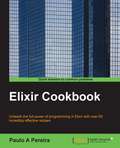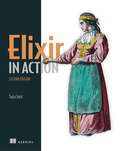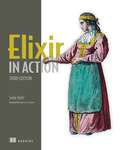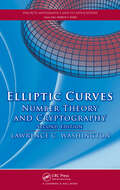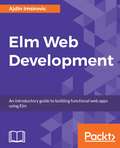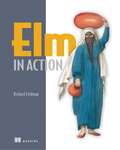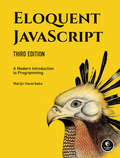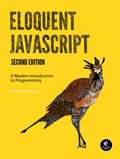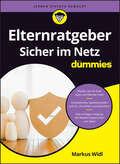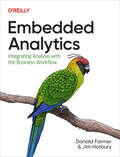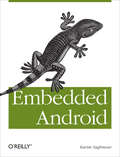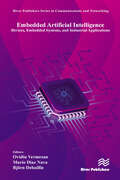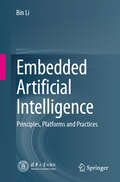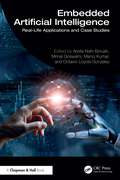- Table View
- List View
Elixir Cookbook
by Paulo A PereiraThis book is intended for users with some knowledge of the Elixir language syntax and basic data types/structures. Although this is a cookbook and no sequential reading is required, the book's structure will allow less advanced users who follow it to be gradually exposed to some of Elixir's features and concepts specific to functional programming. To get the most out of this book, you need to be well versed with Erlang.
Elixir in Action
by Sasa JuricSummaryRevised and updated for Elixir 1.7, Elixir in Action, Second Edition teaches you how to apply Elixir to practical problems associated with scalability, fault tolerance, and high availability. Along the way, you'll develop an appreciation for, and considerable skill in, a functional and concurrent style of programming.Purchase of the print book includes a free eBook in PDF, Kindle, and ePub formats from Manning Publications.About the TechnologyWhen you're building mission-critical software, fault tolerance matters. The Elixir programming language delivers fast, reliable applications, whether you're building a large-scale distributed system, a set of backend services, or a simple web app. And Elixir's elegant syntax and functional programming mindset make your software easy to write, read, and maintain.About the BookElixir in Action, Second Edition teaches you how to build production-quality distributed applications using the Elixir programming language. Author Saša Jurić introduces this powerful language using examples that highlight the benefits of Elixir's functional and concurrent programming. You'll discover how the OTP framework can radically reduce tedious low-level coding tasks. You'll also explore practical approaches to concurrency as you learn to distribute a production system over multiple machines. What's insideUpdated for Elixir 1.7Functional and concurrent programmingIntroduction to distributed system designCreating deployable releasesAbout the ReaderYou'll need intermediate skills with client/server applications and a language like Java, C#, or Ruby. No previous experience with Elixir required.About the AuthorSaša Jurić is a developer with extensive experience using Elixir and Erlang in complex server-side systems.Table of ContentsFirst stepsBuilding blocksControl flowData abstractionsConcurrency primitivesGeneric server processesBuilding a concurrent systemFault-tolerance basicsIsolating error effectsBeyond GenServerWorking with componentsBuilding a distributed systemRunning the system
Elixir in Action, Third Edition (In Action)
by Saša JuricFully updated to Elixir 1.15, this authoritative bestseller reveals how Elixir tackles problems of scalability, fault tolerance, and high availability.Thousands of developers have learned to build applications in Elixir by using Saša Juric&’s Elixir in Action. You&’ll skip the programming basics or 101 introductions; this book builds on your existing knowledge to get you quickly writing real Elixir code. Along the way, you'll develop an appreciation for, and considerable skill in, functional and concurrent programming. Inside Elixir in Action, Third Edition you&’ll find: Updates for Elixir 1.15 Elixir modules, functions, and type system Functional and concurrent programming Introduction to distributed system design Creating deployable releases Fully updated to Elixir 1.15, this book contains new coverage of working with application configuration and the latest OTP releases. It teaches you the underlying principles and functional concepts of Elixir, and how each piece fits into the bigger picture of building production-ready systems with Elixir, Erlang, and the OTP framework. Foreword by Francesco Cesarini. About the technology With best-in-class fault tolerance and concurrency, a pragmatic approach to functional programming, and the power to operate at scale, Elixir is the perfect choice for mission-critical software. Start reading Elixir in Action, and you&’ll quickly understand why Elixir creator José Valim says it &“...tops the list&” of Elixir books. About the book Elixir in Action, Third Edition teaches you how to create distributed applications and server-side systems using Elixir and the Erlang VM. This Third Edition from Elixir expert Saša Juric is fully updated to include the latest features of Elixir 1.15. In it, you&’ll master the foundations of the language, discover how the OTP framework minimizes tedious boilerplate code, and explore numerous examples that ensure you&’re learning hands-on. What's inside Elixir modules, functions, and type system Functional and concurrent programming Introduction to distributed system design Creating deployable releases About the reader For programmers comfortable with client/server applications. No experience with Elixir, Erlang, or functional programming required. About the author Saša Juric uses Elixir and Erlang to build fault-tolerant, scalable, highly concurrent systems. Technical editor on this book was Marius Butuc. Table of Contents PART 1 Functional Elixir 1 First steps 2 Building blocks 3 Control flow 4 Data abstractions PART 2 CONCURRENT ELIXIR 5 Concurrency primitives 6 Generic server processes 7 Building a concurrent system 8 Fault tolerance basics 9 Isolating error effects 10 Beyond GenServer PART 3 PRODUCTION 11 Working with components 12 Building a distributed system 13 Running the system
Ellen DeGeneres: From Comedy Club to Talk Show (Extraordinary Success with a High School)
by Jaime SebaIn the last few decades, more and more people are going to college to further their education. It's hard to become a scientist, a professor, or a businessperson without getting some sort of college degree--but college isn't always necessary to achieve success. Some people are ready to enter the workforce right after high school. Ellen DeGeneres was one of those people. The comedian began her career doing stand-up routines in New Orleans coffee houses. Today, Ellen has one of the most successful talk shows on television and stars in commercials for everything from credit cards to makeup. She's even judged "American Idol"! And what's most amazing about her story is that the charming talk show host has done it all without a college degree!
Elliptic Curves: Number Theory and Cryptography, Second Edition (Discrete Mathematics and Its Applications)
by Lawrence C. WashingtonLike its bestselling predecessor, Elliptic Curves: Number Theory and Cryptography, Second Edition develops the theory of elliptic curves to provide a basis for both number theoretic and cryptographic applications. With additional exercises, this edition offers more comprehensive coverage of the fundamental theory, techniques, and application
Elm Web Development: An introductory guide to building functional web apps using Elm
by Ajdin ImsirovicExplore why ELM is a great alternative to using pure JavaScript and other JS-based solutions by building complete apps and websites.Key FeaturesDevelop your own scalable and modular web applications with Elm to make web development less messy compared to your JavaScript appsCreate personal portfolio website, a weather application, and a unit conversion website, and integrate your Elm apps with Rails 5Boost the performance of your application with no runtime exceptions and JavaScript interoperabilityBook DescriptionWeb development with JavaScript usually involves dealing with performance and maintenance issues. JavaScript fatigue makes it difficult for many developers to keep up with the increasing complexity posed by the multitude of JavaScript frameworks with changing versions, and the need to use different tools such as task runners, module bundlers, compilers, testing suites, linting and debuggers. Elm is an easy-to-learn, functional programming language that simplifies web development by eliminating the complexity associated with using JavaScript for web development. Elm is a statically typed language and thus makes a front end web developer's life easier by preventing run-time errors.You will begin by seeing the bigger picture of where Elm fits into the web development world and learning the basics of Elm programming. Firstly, you will get a taste for web development with Elm by developing a simple fizz-buzz app. Next you will get hands-on with advanced Elm concepts as you develop your own personal blogging website, a unit conversion app and a weather app with Elm. Finally, you will also learn how to integrate Elm with a Rails 5 app with the help of Webpack. By the end of the book you will have learned Elm programming, and its applications, and will appreciate how Elm simplifies web development for you.What you will learnProgramming with the Elm language, its syntax and core concepts Using Elm for front end web development projectsDeveloping complete websites with ElmDecoding JSON into ElmIntegrating Elm with the standard front end web development technologiesIntegrating Elm with back-end frameworksTesting your applications in ElmWho this book is forThis book is for frontend web developers who want to learn a simpler way of developing their applications. A knowledge of the basics of CSS and Bootstrap is required.
Elm in Action
by Richard FeldmanSummary Elm is more than just a cutting-edge programming language, it&’s a chance to upgrade the way you think about building web applications. Once you get comfortable with Elm&’s refreshingly different approach to application development, you&’ll be working with a clean syntax, dependable libraries, and a delightful compiler that essentially eliminates runtime exceptions. Elm compiles to JavaScript, so your code runs in any browser, and Elm&’s best-in-class rendering speed will knock your socks off. Let&’s get started! Purchase of the print book includes a free eBook in PDF, Kindle, and ePub formats from Manning Publications. About the technology Simply put, the Elm programming language transforms the way you think about frontend web development. Elm&’s legendary compiler is an incredible assistant, giving you the precise and user-friendly support you need to work efficiently. Elm applications have small bundle sizes that run faster than JavaScript frameworks and are famously easy to maintain as they grow. The catch? Elm isn&’t JavaScript, so you&’ll have some new skills to learn. About the book Elm in Action teaches you the Elm language along with a new approach to coding frontend applications. Chapter by chapter, you&’ll create a full-featured photo-browsing app, learning as you go about Elm&’s modular architecture, Elm testing, and how to work seamlessly with your favorite JavaScript libraries. You&’ll especially appreciate author and Elm core team member Richard Feldman&’s unique insights, based on his thousands of hours writing production code in Elm. When you&’re done, you&’ll have a toolbox of new development skills and a stunning web app for your portfolio. What's inside Scalable design for production web applications Single-page applications in Elm Data modeling in Elm Accessing JavaScript from Elm About the reader For web developers with no prior experience in Elm or functional programming. About the author Richard Feldman is a software engineer at NoRedInk and a well-known member of the Elm community. Table of Contents PART 1 - GETTING STARTED 1. Welcome to Elm 2. Your first Elm application 3. Compiler as assistant PART 2 - PRODUCTION-GRADE ELM 4. Talking to servers 5. Talking to JavaScript 6. Testing PART 3 - BUILDING BIGGER 7. Data modeling 8. Single-page applications
Elon Musk
by Walter IsaacsonThe #1 New York Times and global bestseller from Walter Isaacson—the acclaimed author of Steve Jobs, Einstein: His Life and World, Benjamin Franklin, and Leonardo da Vinci—is the astonishingly intimate story of the most fascinating, controversial innovator of modern times. For two years, Isaacson shadowed Elon Musk as he executed his vision for electric vehicles at Tesla, space exploration with SpaceX, the AI revolution, and the takeover of Twitter and its conversion to X. The result is the definitive portrait of the mercurial pioneer that offers clues to his political instincts, future ambitions, and overall worldview. When Elon Musk was a kid in South Africa, he was regularly beaten by bullies. One day a group pushed him down some concrete steps and kicked him until his face was a swollen ball of flesh. He was in the hospital for a week. But the physical scars were minor compared to the emotional ones inflicted by his father, an engineer, rogue, and charismatic fantasist. His father&’s impact on his psyche would linger. He developed into a tough yet vulnerable man-child, prone to abrupt Jekyll-and-Hyde mood swings, with an exceedingly high tolerance for risk, a craving for drama, an epic sense of mission, and a maniacal intensity that was callous and at times destructive. At the beginning of 2022—after a year marked by SpaceX launching thirty-one rockets into orbit, Tesla selling a million cars, and him becoming the richest man on earth—Musk spoke ruefully about his compulsion to stir up dramas. &“I need to shift my mindset away from being in crisis mode, which it has been for about fourteen years now, or arguably most of my life,&” he said. It was a wistful comment, not a New Year&’s resolution. Even as he said it, he was secretly buying up shares of Twitter, the world&’s ultimate playground. Over the years, whenever he was in a dark place, his mind went back to being bullied on the playground. Now he had the chance to own the playground. For two years, Isaacson shadowed Musk, attended his meetings, walked his factories with him, and spent hours interviewing him, his family, friends, coworkers, and adversaries. The result is the revealing inside story, filled with amazing tales of triumphs and turmoil, that addresses the question: are the demons that drive Musk also what it takes to drive innovation and progress?
Elon Musk (edición en español)
by Walter IsaacsonDel autor de Steve Jobs y otras grandes biografías, todas ellas éxitos internacionales de ventas, esta es la historia asombrosamente íntima del innovador más fascinante y polémico del mundo, un visionario que ha roto todos los moldes y ha conducido al mundo a la era de los vehículos eléctricos, la exploración espacial privada y la inteligencia artificial. Ah, y el mismo que compró Twitter.Cuando Elon Musk era un niño en Sudáfrica, sufría a menudo acoso escolar. Un día un grupo de niños lo empujó por unas escaleras de hormigón y le patearon hasta que su cara se hinchó como una pelota. Pasó una semana en el hospital. Pero las cicatrices físicas fueron insignificantes comparadas con las emocionales, las que le había causado su padre, un canalla, ingeniero carismático y fantasioso. Cuando Elon llegó a casa tras ser dado de alta del hospital, su padre le reprendió. «Tuve que escucharlo durante una hora mientras me gritaba, me llamaba idiota y me decía que era un inútil», recuerda. El impacto psicológico que su padre le causó perduró. Se convirtió en un joven fuerte pero vulnerable al mismo tiempo, propenso a bruscos cambios de humor -a lo Jekyll y Hyde-, con una gran tolerancia al riesgo, ansias de drama, un épico sentido de misión y una intensidad maníaca, cruel y a veces destructiva.A principios de 2022, después de un año marcado por el lanzamiento de treinta y un satélites de SpaceX, la venta de un millón de coches de Tesla y de convertirse en el hombre más rico de la tierra, Musk confesó con arrepentimiento su impulso por provocar el drama. «Necesito cambiar mi forma de pensar para que deje de estar en modo crisis, como lo he estado en los últimos catorce años, o probablemente toda mi vida», explicó.Fue un comentario melancólico, no un propósito de año nuevo. Cuando hizo la promesa, estaba comprando en secreto acciones de Twitter, el patio de recreo por excelencia. Con los años, cuando se encontraba en un momento difícil, se veía transportado de nuevo al acoso que sufrió en el patio del colegio. Ahora tenía la oportunidad de poseerlo. Durante dos años, Isaacson fue la sombra de Musk, asistió a sus reuniones, recorrió juntos sus fábricas, y pasó horas entrevistándolo a él, a su familia, amigos, compañeros y adversarios. El resultado es un relato íntimo y revelador, repleto de historias asombrosas, triunfos y perturbaciones, que aborda la pregunta: ¿son los demonios que mueven a Musk también lo que se necesita para impulsar la innovación y el progreso?
Elon Musk: Tesla, SpaceX, and the Quest for a Fantastic Future
by Ashlee Vance<p>In the spirit of Steve Jobs and Moneyball, <i>Elon Musk</i> is both an illuminating and authorized look at the extraordinary life of one of Silicon Valley's most exciting, unpredictable, and ambitious entrepreneurs--a real-life Tony Stark--and a fascinating exploration of the renewal of American invention and its new "makers". <p>Ashlee Vance spotlights the technology and vision of Elon Musk, the renowned entrepreneur and innovator behind SpaceX, Tesla, and SolarCity, who sold one of his Internet companies, PayPal, for $1.5 billion. Ashlee Vance captures the full spectacle and arc of the genius's life and work, from his tumultuous upbringing in South Africa and flight to the United States to his dramatic technical innovations and entrepreneurial pursuits. <p>Vance uses Musk's story to explore one of the pressing questions of our age: can the nation of inventors and creators who led the modern world for a century still compete in an age of fierce global competition? He argues that Musk--one of the most unusual and striking figures in American business history--is a contemporary, visionary amalgam of legendary inventors and industrialists including Thomas Edison, Henry Ford, Howard Hughes, and Steve Jobs. More than any other entrepreneur today, Musk has dedicated his energies and his own vast fortune to inventing a future that is as rich and far-reaching as the visionaries of the golden age of science-fiction fantasy. <p>Thorough and insightful, <i>Elon Musk</i> brings to life a technology industry that is rapidly and dramatically changing by examining the life of one of its most powerful and influential titans.</p> <p><b>A New York Times Bestseller</b></p>
Eloquent Images: Word and Image in the Age of New Media
by Mary E. Hocks Michelle R. KendrickThe emergence of New Media has stimulated debate about the power of the visual to dethrone the cultural prominence of textuality and print. Some scholars celebrate the proliferation of digital images, arguing that it suggests a return to a pictorial age when knowledge was communicated through images as well as through words. Others argue that the inherent conflict between texts and images creates a battleground between the feminized, seductive power of images and the masculine rationality of the printed word. Eloquent Imagessuggests that these debates misunderstand the dynamic interplay that has always existed between word and image. Arguing that the complex relationship between text and image in New Media does not represent a radical rupture from the past, the book examines rhetorical and cultural uses of word and image both historically and currently. It shows that complex, interpenetrating relationships between verbal and visual communication systems were already evident in hieroglyphic writing and in ancient rhetoric and persist in the work of classical rhetoricians, in cultural studies of technology, even in the binary code distinctions of digital environments. The essays blend theory, critique, and design practice to explore the often contradictory relations of word and image. All of them call for theoretically grounded approaches to hypermedia design.
Eloquent JavaScript, 3rd Edition: A Modern Introduction to Programming
by Marijn HaverbekeCompletely revised and updated, this best-selling introduction to programming in JavaScript focuses on writing real applications.JavaScript lies at the heart of almost every modern web application, from social apps like Twitter to browser-based game frameworks like Phaser and Babylon. Though simple for beginners to pick up and play with, JavaScript is a flexible, complex language that you can use to build full-scale applications.This much anticipated and thoroughly revised third edition of Eloquent JavaScript dives deep into the JavaScript language to show you how to write beautiful, effective code. It has been updated to reflect the current state of Java¬Script and web browsers and includes brand-new material on features like class notation, arrow functions, iterators, async functions, template strings, and block scope. A host of new exercises have also been added to test your skills and keep you on track. As with previous editions, Haverbeke continues to teach through extensive examples and immerses you in code from the start, while exercises and full-chapter projects give you hands-on experience with writing your own programs. You start by learning the basic structure of the JavaScript language as well as control structures, functions, and data structures to help you write basic programs. Then you'll learn about error handling and bug fixing, modularity, and asynchronous programming before moving on to web browsers and how JavaScript is used to program them. As you build projects such as an artificial life simulation, a simple programming language, and a paint program, you'll learn how to:- Understand the essential elements of programming, including syntax, control, and data- Organize and clarify your code with object-oriented and functional programming techniques- Script the browser and make basic web applications- Use the DOM effectively to interact with browsers- Harness Node.js to build servers and utilitiesIsn't it time you became fluent in the language of the Web?* All source code is available online in an inter¬active sandbox, where you can edit the code, run it, and see its output instantly.
Eloquent JavaScript, 4th Edition
by Marijn HaverbekeStart building beautiful web applications in JavaScript with the bestselling introduction to the language, updated with new features, fresh exercises, and fun projects.JavaScript, the programming language that allows us to add programs to web pages, lies at the heart of almost every modern web application, from social media sites to browser-based games. Just about every device can run it, making it a great choice for writing universally useful code.The fourth edition of this classic textbook takes you on a journey through the language of the web, starting from its basic elements and building up to engaging, complete programs. The author&’s personal experiences from years of maintaining popular open source projects enliven the text with practical insights and examples. This edition of Eloquent JavaScript updates the book to describe the 2024 version of JavaScript, and shifts the attention given to some topics to better reflect current development practices.The text takes a practical approach to teaching, rooting theory in plenty of motivating examples. The first half of the book describes the fundamentals of the language, whereas the second half shows how to apply it in two programming environments: the web browser and Node.js. Five project chapters show how to build bigger programs, working through these projects in a piecemeal, conversational way. They include a pathfinding robot, a small programming language, a platform game, a pixel drawing program, and a simple dynamic website.Exercises provided at the end of most chapters will challenge you to creatively apply the concepts and techniques introduced. The book&’s companion website provides an interactive environment for working on these exercises and playing with the example programs.Whether you&’re looking to learn JavaScript or to deepen your programming skills, you&’ll find this book full of stimulating material.Updated to ECMAScript 2024
Eloquent JavaScript: A Modern Introduction to Programming
by Marijn Haverbeke<P>JavaScript is at the heart of almost every modern Web application, whether it's Google Apps, Twitter, or the newest browser-based game. Though it's simple for beginners to pick up and play with, JavaScript is not a toy—it's a flexible and complex language that can be used to build full-scale applications. <P>Eloquent JavaScript dives into this flourishing language and teaches you to write code that's beautiful and effective. By immersing you in example code and encouraging experimentation right from the start, the author quickly gives you the tools you need to build your own programs. As you follow along with examples like an artificial life simulation and a version of the classic game Sokoban, you'll learn to: <br>–Understand the essential elements of programming: syntax, control, and data <br>–Use object-oriented and functional programming techniques to organize and clarify your programs <br>–Script the browser and make basic Web applications <br>–Work with tools like regular expressions and XMLHttpRequest objects <P>And since programming is an art that's best learned by doing, all example code is available online in an interactive sandbox for you to experiment with. With Eloquent JavaScript as your guide, you can tweak, expand, and modify the author's code, or throw it away and build your own creations from scratch. Before you know it, you'll be fluent in the language of the Web.
Eloquent JavaScript: A Modern Introduction to Programming (Second Edition)
by Marijn Haverbeke<P>JavaScript lies at the heart of almost every modern web application, from social apps to the newest browser-based games. Though simple for beginners to pick up and play with, JavaScript is a flexible, complex language that you can use to build full-scale applications. <P>Eloquent JavaScript, 2nd Edition dives deep into the JavaScript language to show you how to write beautiful, effective code. Author Marijn Haverbeke immerses you in example code from the start, while exercises and full-chapter projects give you hands-on experience with writing your own programs. As you build projects such as an artificial life simulation, a simple programming language, and a paint program, you’ll learn: <br>–The essential elements of programming, including syntax, control, and data <br>–How to organize and clarify your code with object-oriented and functional programming techniques <br>–How to script the browser and make basic web applications–How to use the DOM effectively to interact with browsers <br>–How to harness Node.js to build servers and utilities <P>This edition is thoroughly revised and modernized to reflect the current state of JavaScript and web browsers, with brand-new material, such as a chapter on code performance in JavaScript, and expanded coverage of recursion and closures. All source code is available online in an interactive sandbox, where you can edit the code, run it, and see its output instantly. <P>Isn’t it time you became fluent in the language of the Web?
Elternratgeber: Sicher im Netz für Dummies (Für Dummies)
by Markus WidlSichere Mediennutzung begleiten Welche Apps und Dienste fördern und unterhalten Ihr Kind, wo lauert Gefahr? Mit diesem Buch richten Sie Smartphones, Tablets, PCs und Spielekonsolen altersgerecht ein und vermitteln Ihrem Kind fundiert den richtigen Umgang mit (Online-)Medien. Sie verstehen, wie bei Kindern und Jugendlichen verbreitete Apps oder Dienste auf allen gängigen Gerätetypen funktionieren und vernetzt sind. Und wie Sie die Zugriffsmöglichkeiten so steuern, wie Sie es für Ihr Kind für geeignet halten. So kann Ihr Kind sicher surfen, spielen oder soziale Netzwerke nutzen. Sie erfahren Wie Kinder digitale Medien nutzen Was erlaubt ist und was nicht Welche Einstellungen Sie kennen sollten Wie Sie sich und Ihre Kinder vor digitalen Angriffen schützen
Email Discourse Among Chinese Using English as a Lingua Franca
by Yuan-Shan Chen Der-Hwa Victoria Rau Gerald RauThis edited volume makes a valuable contribution to the burgeoning research field of English as a lingua franca. In a pioneering step, the collection is exclusively devoted to the English email discourse of Chinese speakers. The studies address innovative topics related to various contexts and relationships, using several different approaches and theories, which taken together shed light on how English serves as a lingua franca in multiple types of global written communication. The research topics presented are organized into four thematic sections, including emails from students to professors, emails from students to the international academic community, emails from peer to peer, and emails at the workplace. This collection of empirical research invites readers to consider the special features of apologies, requests, terms of address, politeness, and discourse organization, and how cultural differences may affect the use or interpretation of each. Throughout the book, readers will also discover how Chinese speakers use special features and strategies to construct their identity, establish relationships, and achieve successful communication in English. This highly informative, thought-provoking book also provides insights on methods for teaching email discourse using English as a lingua franca and suggests directions for future research.
Email and the Everyday: Stories of Disclosure, Trust, and Digital Labor
by Esther MilneAn exploration of how email is experienced, understood, and materially structured as a practice spanning our everyday domestic and work lives.Despite its many obituaries, email is not dead. As a global mode of business and personal communication, email outstrips newer technologies of online interaction; it is deeply embedded in our everyday lives. And yet--perhaps because the ubiquity of email has obscured its study--this is the first scholarly book devoted to email as a key historical, social, and commercial site of digital communication in our everyday lives. In Email and the Everyday, Esther Milne examines how email is experienced, understood, and materially structured as a practice spanning the domestic and institutional spaces of daily life.
Emarketing Excellence: Planning and Optimizing your Digital Marketing
by Pr Smith Dave ChaffeyNow in its fourth edition, the hugely successful Emarketing Excellence is fully updated; keeping you in line with the changes in this dynamic and exciting field and helping you create effective and up-to-date customer-centric e-marketing plans. A practical guide to creating and executing e-marketing plans, it combines established approaches to marketing planning with the creative use of new e-models and e-tools. This new edition seamlessly integrates social media technology like Facebook check-in, social networking, tablets and mobile applications into the mix, demonstrating how these new ways to reach customers can be integrated into your marketing plans. It also includes brand new sections on online marketing legislation and QR codes, plus an expanded section on email marketing, the most commonly used e-marketing tool. Offering a highly structured and accessible guide to a critical and far-reaching subject, Emarketing Excellence 4e provides a vital reference point for all students of business or marketing and marketers and e-marketers involved in marketing strategy and implementation and who want a thorough yet practical grounding in e-marketing.
Embedded Analytics: Integrating Analysis with the Business Workflow
by Donald Farmer Jim HorburyOver the past 10 years, data analytics and data visualization have become essential components of an enterprise information strategy. And yet, the adoption of data analytics has remained remarkably static, reaching no more than 30% of potential users. This book explores the most important techniques for taking that adoption further: embedding analytics into the workflow of our everyday operations.Authors Donald Farmer and Jim Horbury show business users how to improve decision making without becoming analytics specialists. You'll explore different techniques for exchanging data, insights, and events between analytics platforms and hosting applications. You'll also examine issues including data governance and regulatory compliance and learn best practices for deploying and managing embedded analytics at scale.Learn how data analytics improves business decision making and performanceExplore advantages and disadvantages of different embedded analytics platformsDevelop a strategy for embedded analytics in an organization or productDefine the architecture of an embedded solutionSelect vendors, platforms, and tools to implement your architecture Hire or train developers and architects to build the embedded solutions you needUnderstand how embedded analytics interacts with traditional analytics
Embedded Android
by Karim Yaghmour<p>Embedded Android is for Developers wanting to create embedded systems based on Android and for those wanting to port Android to new hardware, or creating a custom development environment. Hackers and moders will also find this an indispensible guide to how Android works.</p>
Embedded Artificial Intelligence: Devices, Embedded Systems, and Industrial Applications
by Ovidiu Vermesan Mario Diaz Nava Björn DebaillieRecent technological developments in sensors, edge computing, connectivity, and artificial intelligence (AI) technologies have accelerated the integration of data analysis based on embedded AI capabilities into resource-constrained, energy-efficient hardware devices for processing information at the network edge. Embedded AI combines embedded machine learning (ML) and deep learning (DL) based on neural networks (NN) architectures such as convolutional NN (CNN), or spiking neural network (SNN) and algorithms on edge devices and implements edge computing capabilities that enable data processing and analysis without optimised connectivity and integration, allowing users to access data from various sources. Embedded AI efficiently implements edge computing and AI processes on resource-constrained devices to mitigate downtime and service latency, and it successfully merges AI processes as a pivotal component in edge computing and embedded system devices. Embedded AI also enables users to reduce costs, communication, and processing time by assembling data and by supporting user requirements without the need for continuous interaction with physical locations. This book provides an overview of the latest research results and activities in industrial embedded AI technologies and applications, based on close cooperation between three large-scale ECSEL JU projects, AI4DI, ANDANTE, and TEMPO. The book’s content targets researchers, designers, developers, academics, post-graduate students and practitioners seeking recent research on embedded AI. It combines the latest developments in embedded AI, addressing methodologies, tools, and techniques to offer insight into technological trends and their use across different industries.
Embedded Artificial Intelligence: Principles, Platforms and Practices
by Bin LiThis book focuses on the emerging topic of embedded artificial intelligence and provides a systematic summary of its principles, platforms, and practices. In the section on principles, it analyzes three main approaches for implementing embedded artificial intelligence: cloud computing mode, local mode, and local-cloud collaborative mode. The book identifies five essential components for implementing embedded artificial intelligence: embedded AI accelerator chips, lightweight neural network algorithms, model compression techniques, compiler optimization techniques, and multi-level cascaded application frameworks. The platform section introduces mainstream embedded AI accelerator chips and software frameworks currently used in the industry. The practical part outlines the development process of embedded artificial intelligence and showcases real-world application examples with accompanying code. As a comprehensive guide to the emerging field of embedded artificial intelligence, the book offers rich and in-depth content, a clear and logical structure, and a balanced approach to both theoretical analysis and practical applications. It provides significant reference value and can serve as an introductory and reference guide for researchers, scholars, students, engineers, and professionals interested in studying and implementing embedded artificial intelligence.
Embedded Artificial Intelligence: Real-Life Applications and Case Studies
by Manoj Kumar Octavio Loyola-González Mrinal Goswami Arpita Nath BoruahThis book explores the role of embedded AI in revolutionizing industries such as healthcare, transportation, manufacturing, and retail. It begins by introducing the fundamentals of AI and embedded systems and specific challenges and opportunities. A key focus of this book is developing efficient and effective algorithms and models for embedded AI systems, as embedded systems have limited processing power, memory, and storage. It discusses a variety of techniques for optimizing algorithms and models for embedded systems, including hardware acceleration, model compression, and quantization.Key features: Explores security experiments in emerging post‑CMOS technologies using AI, including side channel attack‑resistant embedded systems Discusses different hardware and software platforms available for developing embedded AI applications, as well as the various techniques used to design and implement these systems Considers ethical and societal implications of embedded AI vis‑a‑vis the need for responsible development and deployment of embedded AI systems Focuses on application‑based research and case studies to develop embedded AI systems for real‑life applications Examines high‑end parallel systems to run complex AI algorithms and comprehensive functionality while maintaining portability and power efficiency This reference book is for students, researchers, and professionals interested in embedded AI and relevant branches of computer science, electrical engineering, or artificial intelligence.
Embedded Computer Systems: 19th International Conference, SAMOS 2019, Samos, Greece, July 7–11, 2019, Proceedings (Lecture Notes in Computer Science #11733)
by Maxime Pelcat Matthias Jung Dionisios N. PnevmatikatosThis book constitutes the refereed proceedings of the 19th International Conference on Embedded Computer Systems: Architectures, Modeling, and Simulation, SAMOS 2019, held in Pythagorion, Samos, Greece, in July 2019.The 21 regular papers presented were carefully reviewed and selected from 55 submissions. The papers are organized in topical sections on system design space exploration; deep learning optimization; system security; multi/many-core scheduling; system energy and heat management; many-core communication; and electronic system-level design and verification. In addition there are 13 papers from three special sessions which were organized on topics of current interest: insights from negative results; machine learning implementations; and European projects.
